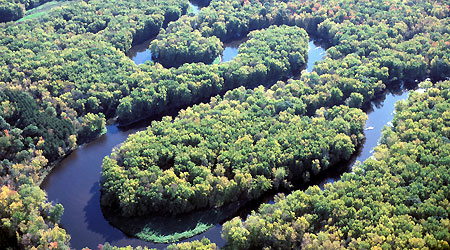Bottomland hardwoods are one of the lowest in elevation and the wettest types of hardwood forests.
Bottomland hardwoods definition.
These ecosystems are commonly found wherever streams or rivers cause flooding beyond their channels.
Forest service research ecologist mac callaham along with several colleagues asked that question about bottomland hardwoods in west central mississippi.
Under the usfws wetlands classification blh are in the palustrine system forested class and either the broad leaved or needle leaved deciduous subclasses cowardin et al 1979.
The bottomland hardwood forest is a type of deciduous hardwood forest found in broad lowland floodplains along large rivers and lakes.
They are located in the southeast and south central united states generally in broad floodplains.
1 they are occasionally flooded which builds up the alluvial soils required for the gum oak and bald cyprus trees that typically grow in this type of biome.
The bottomland hardwood forest is a type of deciduous and evergreen hardwood forest found in us broad lowland floodplains along large rivers and lakes.
Bottomland hardwoods bottomland hardwoods blh are basically wet floodplain forests that are subject to regular seasonal flooding events.
They are generally found along the edges of lakes and rivers and in sinkholes.
The term bottomland hardwoods was first used to describe forests of the southeastern us that occurred on river floodplains.
2 the trees often develop signs of wetland trees including knees but can not survive continuous.
These ecosystems are commonly found wherever streams or rivers at least occasionally cause flooding beyond their channel confines.
Like all wetland ecosystems.
They are found along rivers and streams of the southeast and south central united states generally in broad floodplains.
Back in the late 1960s there was a soybean boom and a lot of bottomland forests were cleared for farming says callaham.
They vary in drainage and nutrient levels thus resulting in a range of sites with different productivity levels appropriate for different hardwood species.
Bottomland hardwood forests are river swamps.
Bottomland hardwood forests are flooded forests occurring along waterways.
They are occasionally flooded which builds up the alluvial soils required for the gum oak and bald cypress trees that typically grow in this type of biome.
Bottomland forests represent a transition between drier upland hardwood forest and very wet river floodplain and wetland forests.
These forests are critically important to biodiversity wildlife carbon storage recreation and clean water in the south.
Bottomland hardwoods management an ecological approach to bottomland hardwoods bottomland hardwood forests are floodplain forests that are periodically inundated or saturated during the growing season.
The term bottomland hardwoods generally refers to hardwoods found on current floodplain sites.

